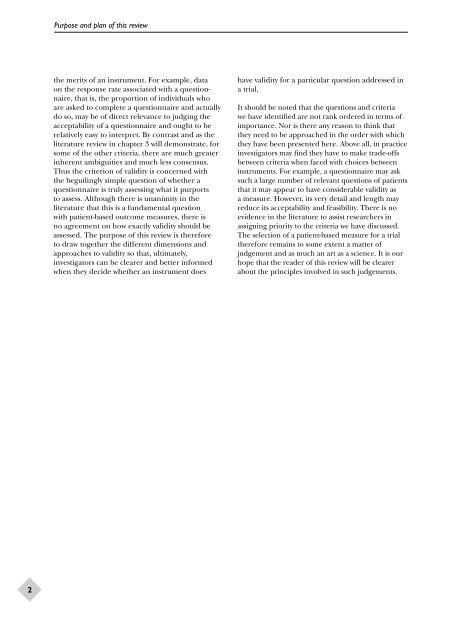Evaluating Patient-Based Outcome Measures - NIHR Health ...
Evaluating Patient-Based Outcome Measures - NIHR Health ...
Evaluating Patient-Based Outcome Measures - NIHR Health ...
You also want an ePaper? Increase the reach of your titles
YUMPU automatically turns print PDFs into web optimized ePapers that Google loves.
2<br />
Purpose and plan of this review<br />
the merits of an instrument. For example, data<br />
on the response rate associated with a questionnaire,<br />
that is, the proportion of individuals who<br />
are asked to complete a questionnaire and actually<br />
do so, may be of direct relevance to judging the<br />
acceptability of a questionnaire and ought to be<br />
relatively easy to interpret. By contrast and as the<br />
literature review in chapter 3 will demonstrate, for<br />
some of the other criteria, there are much greater<br />
inherent ambiguities and much less consensus.<br />
Thus the criterion of validity is concerned with<br />
the beguilingly simple question of whether a<br />
questionnaire is truly assessing what it purports<br />
to assess. Although there is unanimity in the<br />
literature that this is a fundamental question<br />
with patient-based outcome measures, there is<br />
no agreement on how exactly validity should be<br />
assessed. The purpose of this review is therefore<br />
to draw together the different dimensions and<br />
approaches to validity so that, ultimately,<br />
investigators can be clearer and better informed<br />
when they decide whether an instrument does<br />
have validity for a particular question addressed in<br />
a trial.<br />
It should be noted that the questions and criteria<br />
we have identified are not rank ordered in terms of<br />
importance. Nor is there any reason to think that<br />
they need to be approached in the order with which<br />
they have been presented here. Above all, in practice<br />
investigators may find they have to make trade-offs<br />
between criteria when faced with choices between<br />
instruments. For example, a questionnaire may ask<br />
such a large number of relevant questions of patients<br />
that it may appear to have considerable validity as<br />
a measure. However, its very detail and length may<br />
reduce its acceptability and feasibility. There is no<br />
evidence in the literature to assist researchers in<br />
assigning priority to the criteria we have discussed.<br />
The selection of a patient-based measure for a trial<br />
therefore remains to some extent a matter of<br />
judgement and as much an art as a science. It is our<br />
hope that the reader of this review will be clearer<br />
about the principles involved in such judgements.
















